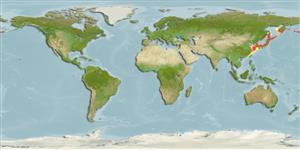Environment: milieu / climate zone / depth range / distribution range
Ecología
marino demersal; oceanodromo; rango de profundidad 8 - 432 m (Ref. 50550). Polar; 3°C - 12°C (Ref. 6373)
Northwest Pacific: Japan Sea, south to Kasumi, Japan and Wonsan, Korea; Pacific coast of Hokkaido; Sea of Okhotsk; Avatcha Bay of eastern Kamchatka.
Length at first maturity / Tamaño / Peso / Age
Maturity: Lm 23.0, range 22 - 24 cm
Max length : 29.0 cm TL macho / no sexado; (Ref. 56527); peso máximo publicado: 192.00 g (Ref. 6373); edad máxima reportada: 6 años (Ref. 56527)
Occurs primarily along the shelf and makes considerable seasonal migrations to its boundary and upper zone of the continental slope where they overwinter (Ref. 6373).
Life cycle and mating behavior
Madurez | Reproducción | Puesta | Huevos | Fecundidad | Larva
Sokolovskaya, T.G., A.S. Sokolovskii and E.I. Sobolevskii, 1998. A list of fishes of Peter the Great Bay (the Sea of Japan). J. Ichthyol. 38(1):1-11. (Ref. 27683)
IUCN Red List Status (Ref. 130435)
Threat to humans
Harmless
Human uses
Más información
ReferenciasAcuiculturaPerfil de acuiculturaRazasGenéticaElectrophoresesheritabilidadEnfermedadesProcesamientoNutrientsMass conversion
ColaboradoresImágenesStamps, Coins Misc.SonidosCiguateraVelocidadTipo de nataciónSuperficie branquialOtolitosCerebrosVisión
Herramientas
Special reports
Download XML
Fuentes de Internet
Estimates based on models
Preferred temperature (Ref.
123201): 0.7 - 17.9, mean 8.6 °C (based on 235 cells).
Phylogenetic diversity index (Ref.
82804): PD
50 = 0.5312 [Uniqueness, from 0.5 = low to 2.0 = high].
Bayesian length-weight: a=0.00389 (0.00180 - 0.00842), b=3.12 (2.94 - 3.30), in cm total length, based on all LWR estimates for this body shape (Ref.
93245).
Nivel trófico (Ref.
69278): 3.3 ±0.1 se; based on diet studies.
Resiliencia (Ref.
120179): Medio, población duplicada en un tiempo mínimo de 1.4-4.4 años (Preliminary K or Fecundity.).
Fishing Vulnerability (Ref.
59153): Low vulnerability (19 of 100).
